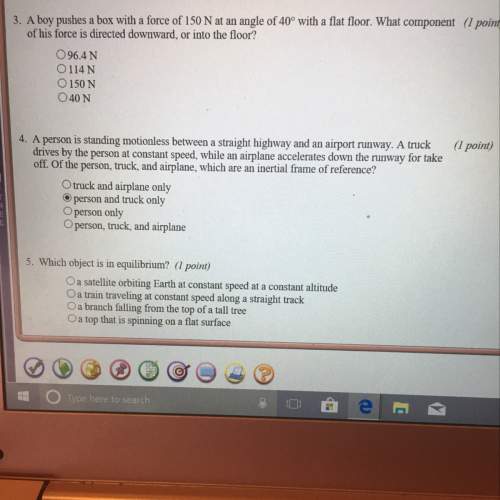
Physics, 04.12.2020 23:00 arianabryant54
A student releases a marble at the top of a ramp and measures the distance the marble travels from
the end of the ramp. He conducts this experiment several times on different surfaces at the end of
the ramp, some rough and some smooth. He observes that the marble travels farther on the
smoother surfaces, but all of the marbles eventually stop.
How can this observation be explained by Newton's First Law of Motion?
The marble stops only when it is acted upon by an outside force.
The marble stops because its natural state is at rest.
The marble stops because of a normal force that is equal and opposite of gravity.
The marble stops only when gravity ceases to exert a force upon it.
Hi

Answers: 2


Another question on Physics

Physics, 22.06.2019 01:50
Arod of some material 0.20 m long elongates 0.20 mm on heating from 21 to 120°c. determine the value of the linear coefficient of thermal expansion [in (degrees c)^-1] for this material.
Answers: 2

Physics, 22.06.2019 13:20
This energy transformation diagram represents the energy of a skateboarder moving along a half-pipe. as she skates toward the top of the half-pipe, her original kinetic energy is converted to potential energy and friction. how much of the energy is potential?
Answers: 3

Physics, 22.06.2019 14:00
Often called simply "velocity," this is the velocity of an object at a particular moment in time.
Answers: 1

Physics, 22.06.2019 15:40
Question 1 what is amperage? is the rate of doing work. is the rate of flow of protons in electric current. represents the amount of pressure behind electron flow. is the rate of flow of electrons in electric current. 2 points question 2 what is voltage? is the rate of doing power. represents the amount of pressure behind electron flow. is the rate of doing work. is the rate of flow of electrons in electric current. 2 points question 3 what is power? is the rate of flow of protons in electric current. is the rate of flow of electrons in electric current. is the rate of doing work. represents the amount of pressure behind electron flow. 2 points question 4 if we multiply volts times amps we get what? power circuit work current 2 points question 5 what are two ways alternating currents are similiar? in both ac and dc electrons flow in the same pattern. in both ac and dc, the flow of electrons changes directions back and forth. both ac and dc are only possible in certain materials with atoms that will allow electron flow. both ac and dc involve the flow of electrons. 4 points question 6 how does the flow of electrons flow in an alternating current? the flow of electrons is always slower in an alternating current than within a direct current. the flow of electrons is not constant and forward; it changes direction back and forth. electrons flow from from a higher affinity to that of a lower affinity. electron flow is constant and only in a forward direction. 2 points question 7 what is the flow like in a direct current? the flow of electrons is not constant and forward; it changes direction back and forth. the flow of electrons is constant and only in a forward direction. the flow of electrons go from a higher affinity to a lower affinity. the flow of electrons are always faster in a direct current. 2 points question 8 how is an electric current able to flow? electrons flow from the higher affinity to lower affinity and electrical current is generated. protons flow from the higher affinity to lower affinity and electrical current is generated. the movement of protons from one atom to another leads to an electric charge. the movement of electrons from one atom to another atom in a line results in a flow of electric current. 2 points question 9 how do electrons move from the two different types of metal in a battery? protons flow from the metal with the lower affinity to the metal with higher affinity and electrical current is generated. electrons flow from the metal with the lower affinity to the metal with higher affinity and electrical current is generated. electrons flow from the metal with the higher affinity to the metal with lower affinity and electrical current is generated. protons flow from the metal with the higher affinity to the metal with lower affinity and electrical current is generated.
Answers: 2
You know the right answer?
A student releases a marble at the top of a ramp and measures the distance the marble travels from...
Questions

Mathematics, 05.05.2021 03:20

Mathematics, 05.05.2021 03:20


Mathematics, 05.05.2021 03:20


Physics, 05.05.2021 03:20



Health, 05.05.2021 03:20




Chemistry, 05.05.2021 03:20

Arts, 05.05.2021 03:20


Mathematics, 05.05.2021 03:20


Business, 05.05.2021 03:20

English, 05.05.2021 03:20




